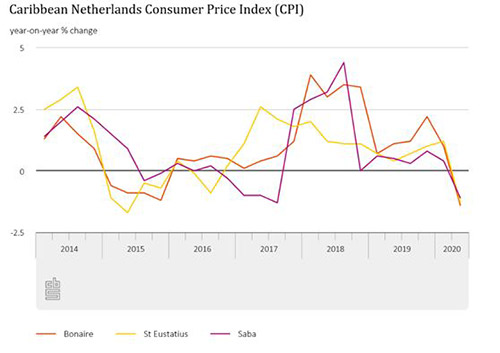In the second quarter of 2020, consumer prices on Bonaire for goods and services were 1.4 percent cheaper than one year previously.
This is reported by Statistics Netherlands (CBS) on the basis of the consumer price index for the Caribbean Netherlands (Bonaire, St. Eustatius, and Saba).
The consumer prices on Bonaire decrease are mainly attributable to the allowances for electricity, drinking water, and the internet, which have been provided by the government as of 1 May 2020. As a result, the fixed usage tariffs for electricity and drinking water amount to USD $0.00 and fixed internet subscribers receive a monthly discount of USD $25. Although figures for the second quarter also include the old tariffs from April, the effect of the allowances is clearly reflected in the figures.
The consumer prices on Bonaire, in average levels, declined by 1.4 percent relative to Q2 2019.
Due to the government measures, prices for telecommunications dropped by 19.4 percent on average relative to Q1 2020. In Q2 2020, electricity was 11.7 percent cheaper and water 11.2 percent cheaper than in the previous quarter.
Impact of the corona crisis on compiling the consumer price index for Bonaire (CPI)
Due to the government measures, the availability of many services was limited during parts of the second quarter of 2020. As a result, prices could not always be observed for some products. CBS chose an appropriate estimation method for these products.
The corona crisis has had an impact on how the Consumer Price Index (CPI) for the Caribbean Netherlands is compiled. This is primarily due to the fact that particular services became unavailable, which means that there were no prices for these services. In addition, the purchasing behavior of consumers has changed while, at the same time, it has become more difficult – and in some cases even impossible – to observe prices.
Depending on the situation, Statistics Netherlands (CBS) employs different methods to arrive at a fictional price for these goods and services. The methods are in accordance with those we apply to calculate the Netherlands’ CPI. For the CPI Netherlands, we follow the guidelines drawn up by Eurostat, the EU statistical office. This means there is consistency between the solutions we have provided for both the Netherlands and the Caribbean Netherlands. The solutions adopted will enable CBS to continue to publish the CPI in full and to ensure that in due course the price development calculated between the post-corona and pre-corona period will reflect reality.
Due to the fact that daily lives have changed, residents are also spending their money differently: the contents of the average shopping basket have changed. Sports clubs and fitness centers were closed, flights were unavailable, and cafés and restaurants were closed temporarily on Saba and St Eustatius. Instead, consumers are more likely to buy more products in supermarkets. At the same time, it was difficult to observe all the prices we needed to compile the CPI, as it meant visits to shops were necessary.
Why is the CPI compiled?
The main measure of consumer price development is the change in the CPI over a period of twelve months. We compare the price level in Q2 2020 with the price level in Q2 2019. As price changes from quarter to quarter are more noticeable for consumers, we focus on these as well.
The year-on-year change in the CPI is an important measure of inflation. The CPI shows to what extent household income has to rise in order to buy the same products and services. It is therefore widely used for indexation. If income rises in line with the CPI, the purchasing power of local households will be preserved and they can buy the same. Indexation is used not only to adjust salaries or pensions but also to help set rental prices and all kinds of other consumer contract rates.
Problems affecting the CPI due to the corona crisis
During the corona crisis, three factors have had a significant impact on how the CPI is compiled:
- Consumers’ purchasing behavior changes (hoarding, for instance);
- Price observation made more difficult or even impossible;
- Certain goods and services are no longer available (e.g. sports and fitness clubs, casinos, dance venues, flights).
The first factor has no effect on how the CPI is currently compiled because CBS follows the price development of a fixed ‘shopping basket’ of goods and services. In the long term, however, it may have an effect if patterns of consumption alter permanently.
The almost complete absence of certain services (e.g. flights) is a unique situation for the CPI and poses a problem for price statistics in general.
Provisional figures
Figures referring to Q2 2020 are provisional and will become definitive upon publication of the figures over Q3 2020.
(Source: CBS)













